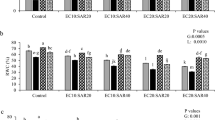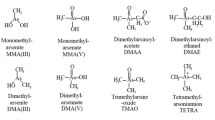Abstract
Plants are the primary producers of food for human being. Their intracellular environment alternation is influenced by abiotic stress factors such as drought, heat and soil salinity. Aeluropus lagopoides is a strong halophyte that grows with ease under high saline muddy banks of creeks of Gujarat, India. To study the response of salinity on metabolite changes in Aeluropus, three treatments, i.e. control, salinity and recovery, were selected for both shoot and root tissue. The cytosolic metabolite state was analysed by molecular chemical derivatization gas chromatography mass profiling. During saline treatment, significant increase of compatible solutes in shoot and root tissue was observed as compared to control. Subsequently, metabolic concentration decreased under recovery conditions. The metabolites like amino acids, organic acids and polyols were significantly detected in both shoot and root of Aeluropus under salinity. The metabolites like proline, aspartic acid, glycine, succinic acid and glycolic acid were significantly upregulated under stress. The salicylic acid was found to play a role in maintaining the polyols level by its down-regulation during salinity. The principle component analysis of all detected metabolites in both shoot and root showed that metabolites expressed under salinity (component 1) were highly variable, while metabolites expressed under recovery (component 2) were comparatively less variable as compared to control. The evolved intracellular compartmentalization of amino acids, organic acids and polyols in A. lagopoides can be a hallmark to sustaining at high salinity stress.





Similar content being viewed by others
References
Ashraf M (1994) Organic substances responsible for salt tolerance in Eruca sativa. Biol Plant 36:255–259
Ashraf M, Fatima H (1995) Responses of some salt tolerant and salt sensitive lines of safflower (Carthamus tinctorius L.) Acta Physiol Plant 17:61–71
Ashraf M, Tufail M (1995) Variation in salinity tolerance in sunflower (Helianthus annum L.) J Agron Crop Sci 174:351–362
Barchet GLH, Dauwe R, Guy RD, Schroeder WR, Soolanayakanahally RY, Campbell MM, Mansfield SD (2014) Investigating the drought-stress response of hybrid poplar genotypes by metabolite profiling. Tree Physiol 34:1203–1219
Buseman MC, Tamura P, Sparks AA, Baughman EJ, Maatta S, Zhao J, Roth MR, Esch SW, Shah J, Williams TD, Welti R (2006) Wounding stimulates the accumulation of glycerolipids containing oxophytodienoic acid and dinor-oxophytodienoic acid in Arabidopsis leaves. Plant Physiol 142:28–39
Dunn WB, Ellis EI (2005) Metabolomics: current analytical platforms and methodologies. Trends Anal Chem 24:285–294
Fernie AR (2013) Gas-chromatography mass-spectrometry (GC-MS) based metabolite profiling reveals mannitol as a major storage carbohydrate in the coccolithophorid alga Emiliania huxleyi. Meta 3:168–184
Fiehn O, Kopka J, Dörmann P, Altmann T, Trethewey RN, Willmitzer L (2000) Metabolite profiling for plant functional genomics. Nat Biotechnol 18:1157–1161
Flowers TJ, Colmer TD (2008) Salinity tolerance in halophytes. New Phytol 179:945–963
Fougere F, Le Rudulier D, Streeter JG (1991) Effects of salt stress on amino acid, organic acid, and carbohydrate composition of roots, bacteroids, and cytosol of alfalfa (Medicago sativa L.) Plant Physiol 96:1228–1236
Gall H, Philippe F, Domon JM, Gillet F, Pelloux J, Rayon C (2015) Cell wall metabolism in response to abiotic stress. Plants (Basel) 4:112–166
Glenn EP, Brown JJ, Blumwald E (1999) Salt tolerance and crop potential of halophytes. Crit Rev Plant Sci 18:227–255
Gupta B, Huang B (2014) Mechanism of salinity tolerance in plants: physiological, biochemical, and molecular characterization. Int J Genomics 2014(701596):1–18
Halket J, Halket M, Waterman D, Przyborowska AM, Patel RKP, Fraser PD (2005) Chemical derivatization and mass spectral libraries in metabolic profiling by GC / MS and LC / MS / MS. J Exp Bot 56:219–243
Hayat S, Hayat Q, Alyemeni MN, Wani AS, Pichtel J, Ahmad A (2012) Role of proline under changing environments: a review. Plant Signal Behav 7:1456–1466
Hill CB, Jha D, Bacic A, Tester M, Roessner U (2013) Characterization of ion contents and metabolic responses to salt stress of different arabidopsis AtHKT1;1 genotypes and their parental strains. Mol Plant 6:350–368
Hoagland DR, Arnon DI (1950) The water culture method for growing plants without soil. California Agricultural Experiment Station, Circular No 347, pp 1–39
Hurkman WJ, Tao HP, Tanaka CK (1991) Germin-like polypeptides increase in barley roots during salt stress. Plant Physiol 97:366–374
Iriti M, Faoro F (2009) Chemical diversity and defence metabolism: how plants cope with pathogens and ozone pollution. Int J Mol Sci 10:3371–3399
Jayakannan M, Bose J, Babourina O, Rengel Z, Shabala S (2015) Salicylic acid in plant salinity stress signalling and tolerance. Plant Growth Regul 76:25–40
Kalsoom U, Ij B, Mc B (2016) A review of extraction and analysis: methods for studying osmoregulants in plants. J Chromatogr Sep Tech 7:2157
Kazachkova Y, Batushansky A, Cisneros A, Noemi TZ, Fait A, Barak S (2013) Growth platform-dependent and independent phenotypic and metabolic responses of Arabidopsis thaliana and its halophytic relative Eutrema salsugineum, to salt stress. Plant Physiol 162:1583–1598
Krasensky J, Jonak C (2012) Drought, salt, and temperature stress-induced metabolic rearrangements and regulatory networks. J Exp Bot 63:1593–1608
Kumar A, Kumar A, Lata C, Kumar S (2016) Eco-physiological responses of Aeluropus lagopoides (grass halophyte) and Suaeda nudiflora (non-grass halophyte) under individual and interactive sodic and salt stress. S Afr J Bot 105:36–44
Liang Y, Strelkov SE, Kav NNV (2009) Oxalic acid-mediated stress responses in Brassica napus L. Proteomics 9:3156–3173
Mohsenzadeh S, Malboobi MA, Razavi K, Farrahi-Aschtiani S (2006) Physiological and molecular responses of Aeluropus lagopoides (Poaceae) to water deficit. Environ Exp Bot 56:314–322
Moinuddin M, Gulzar S, Ahmed MZ, Gul B, Koyro HW, Khan MA (2014) Excreting and non-excreting grasses exhibit different salt resistance strategies. AoB Plants 6:plu038
Munns R (2002) Comparative physiology of salt and water stress. Plant Cell Environ 25:239–250
Munns R, Tester M (2008) Mechanisms of salinity tolerance. Annu Rev Plant Biol 59:651–681
Muscolo A, Panuccio MR, Sidari M (2003) Effects of salinity on growth, carbohydrate metabolism and nutritive properties of kikuyu grass (Pennisetum clandestinum Hochst). Plant Sci 164:1103–1110
Naz N, Hameed M, Wahid A, Arshad M, Ahmad MSA (2009) Patterns of ion excretion and survival in two stoloniferous arid zone grasses. Physiol Plant 135:185–195
Nedjimi B (2011) Is salinity tolerance related to osmolytes accumulation in Lygeum spartum L. seedlings. J Saudi Soc Agric Sci 10:81–87
Parvaiz A, Satyawati S (2008) Salt stress and phyto-biochemical responses of plants – a review. Plant Soil Environ 54:89–99
Qiu QS, Guo Y, Dietrich MA, Schumaker KS, Zhu JK (2002) Regulation of SOS1, a plasma membrane Na+/H+ exchanger in Arabidopsis thaliana, by SOS2 and SOS3. Proc Natl Acad Sci USA 99:8436–8441
Rai VK, Sharma SS, Sharma S (1986) Reversal of ABA-induced stomatal closure by phenolic compounds. J Exp Bot 37:129–134
Rajan N, Agarwal P, Patel K, Sanadhya P, Khedia J, Agarwal PK (2014) Molecular characterization and identification of target protein of an important vesicle trafficking gene AlRab7 from a salt excreting halophyte Aeluropus lagopoides. DNA Cell Biol 34:1–9
Rontein D, Nishida I, Tashiro G, Yoshiok K, Wu WI, Voelker DR, Hanson AD (2001) Plants synthesize ethanolamine by direct decarboxylation of serine using a pyridoxal phosphate enzyme. J Biol Chem 276:35523–35529
Roy SJ, Negrão S, Tester M (2014) Salt resistant crop plants. Curr Opin Biotechnol 26:115–124
Sahu BB, Shaw BP (2009) Isolation, identification and expression analysis of salt-induced genes in Suaeda maritima, a natural halophyte, using PCR-based suppression subtractive hybridization. BMC Plant Biol 9:69
Sanadhya P, Agarwal P, Agarwal PK (2015a) Ion homeostasis in a salt-secreting halophytic grass. AoB Plants 7:plv055
Sanadhya P, Agarwal P, Khedia J, Agarwal PK (2015b) A low-affinity K+ transporter AlHKT2;1 from recretohalophyte Aeluropus lagopoides confers salt tolerance in yeast. Mol Biotechnol 57:489–498
Schwab W, Davidovich-Rikanati R, Lewinsohn E (2008) Biosynthesis of plant-derived flavor compounds. Plant J 54:712–732
Sharma A, Gontia I, Agarwal PK, Jha B (2010) Accumulation of heavy metals and its biochemical responses in Salicornia brachiata , an extreme halophyte. Mar Biol Res 6:511–518
Shavrukov Y (2013) Salt stress or salt shock: which genes are we studying? J Exp Bot 64:119–127
Shelden MC, Dias DA, Jayasinghe NS, Bacic A, Roessner U (2016) Root spatial metabolite profiling of two genotypes of barley (Hordeum vulgare L.) reveals differences in response to short-term salt stress. J Exp Bot 67:3731–3745
Shu S, Yuan Y, Chen J, Sun J, Zhang W, Tang Y, Zhong M, Guo S (2015) The role of putrescine in the regulation of proteins and fatty acids of thylakoid membranes under salt stress. Sci Report 5:14390
Shukla PS, Agarwal PK, Jha B (2012) Improved salinity tolerance of Arachis hypogaea (L.) by the interaction of halotolerant plant-growth-promoting rhizobacteria. J Plant Growth Regul 31:195–206
Singh PK, Gautam S (2013) Role of salicylic acid on physiological and biochemical mechanism of salinity stress tolerance in plants. Acta Physiol Plant 35:2345–2353
Slama I, Abdelly C, Bouchereau A, Flowers T, Savoure A (2015) Diversity, distribution and roles of osmoprotective compounds accumulated in halophytes under abiotic stress. Ann Bot 115:433–447
Sobhanian H, Motamed N, Jazii FR, Nakamura T, Komatsu S (2010) Salt stress induced differential proteome and metabolome response in the shoots of Aeluropus lagopoides (poaceae), a halophyte C4 plant. J Proteome Res 9:2882–2897
Storbart AK, Hendry AF (1978) Chlorophyll formation and glycine metabolism in laevulinic acid treated barley leaves. Phytochemistry 17:993–994
Szarka A, Tomasskovics B, Bánhegyi G (2012) The ascorbate-glutathione tocopherol triad in abiotic stress response. Int J Mol Sci 13:4458–4483
Thakur PS and Rai VK (1982) Dynamics of amino acid accumulation in two differentially drought resistant Zea mays cultivars in response to osmotic stress. Environ Exp Bot 22:221-6
Wallace A (1963) Role of chelating agents on the availability of nutrients to plants. Soil Sci Soc Am Proc 27:176–179
Widodo, Patterson JH, Newbigin ED, Teste M, Bacic A, Roessne U (2009) Metabolic responses to salt stress of barley (Hordeum vulgare L.) cultivars, Sahara and clipper, which differ in salinity tolerance. J Exp Bot 60:4089–4103
Wu D, Cai S, Chen M, Ye L, Chen Z, Zhang H, Dai F, Wu F, Zhang G (2013) Tissue metabolic responses to salt stress in wild and cultivated barley. PLoS One 8:e55431
Yancey PH (2005) Organic osmolytes as compatible, metabolic and counteracting cytoprotectants in high osmolarity and other stresses. J Exp Biol 208:2819–2830
Yeo AR (1983) Salinity resistance: physiologies and prices. Physiol Plant 58:214–222
Acknowledgements
CSIR-CSMCRI Communication No.-171/2016 (as provided by BDIM). MKP, PA and PM acknowledge the financial support from CSIR-networking project, DST-WOS-A scheme and DST-INSPIRE fellowship.
Author information
Authors and Affiliations
Corresponding author
Electronic supplementary material
Figure S1
Total ionic chromatograms of metabolites in shoot and root of Aeluropus lagopoides under control, salinity stress and recovery conditions. Chromatogam of each peak retention time, molecular mass, quantity and molecular NIST similarity library search results were represented in Supplementary Tables 1 and 2. (GIF 252 kb)
Figure S2
(GIF 212 kb)
Table S1
(DOCX 34 kb)
Table S2
(DOCX 25 kb)
Table S3
(DOCX 19 kb)
Table S4
(DOCX 17 kb)
Rights and permissions
About this article
Cite this article
Paidi, M., Agarwal, P., More, P. et al. Chemical Derivatization of Metabolite Mass Profiling of the Recretohalophyte Aeluropus lagopoides Revealing Salt Stress Tolerance Mechanism. Mar Biotechnol 19, 207–218 (2017). https://doi.org/10.1007/s10126-017-9745-9
Received:
Accepted:
Published:
Issue Date:
DOI: https://doi.org/10.1007/s10126-017-9745-9




